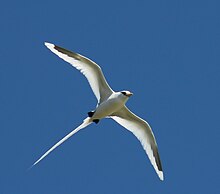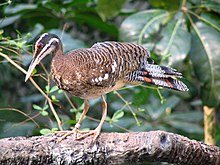Eurypygimorphae: Difference between revisions
Content deleted Content added
taxobox cleanup |
Quisqualis (talk | contribs) ce for clarity |
||
| Line 12: | Line 12: | ||
}} |
}} |
||
'''Eurypygimorphae''' is a [[clade]] of birds that contains the orders [[Phaethontiformes]] (tropicbirds) and [[Eurypygiformes]] ([[kagu]] and [[sunbittern]]) recovered by genome analysis.<ref name=Jarvis2014>{{cite journal | last1 = Jarvis | first1 = E.D. | display-authors = etal | year = 2014 | title = Whole-genome analyses resolve early branches in the tree of life of modern birds | journal = Science | volume = 346 | issue = 6215| pages = 1320–1331 | doi=10.1126/science.1253451 | pmid=25504713 | pmc=4405904}}</ref> The relationship was first identified in 2013 based on their nuclear genes.<ref name="Yuri et al 2013">{{cite journal|last1=Yuri|first1=Tamaki|last2=Kimball|first2=Rebecca|last3=Harshman|first3=John|title=Parsimony and Model-Based Analyses of Indels in Avian Nuclear Genes Reveal Congruent and Incongruent Phylogenetic Signals|journal=Biology|date=2013|volume=2|issue=1|pages=419–444|doi=10.3390/biology2010419|display-authors=etal|pmid=24832669|pmc=4009869}}</ref> Historically these birds were placed at different parts of the tree, with tropicbirds in [[Pelecaniformes]] and the kagu and sunbittern in [[Gruiformes]], though in the last decade various genetic |
'''Eurypygimorphae''' is a [[clade]] of birds that contains the orders [[Phaethontiformes]] (tropicbirds) and [[Eurypygiformes]] ([[kagu]] and [[sunbittern]]) recovered by genome analysis.<ref name=Jarvis2014>{{cite journal | last1 = Jarvis | first1 = E.D. | display-authors = etal | year = 2014 | title = Whole-genome analyses resolve early branches in the tree of life of modern birds | journal = Science | volume = 346 | issue = 6215| pages = 1320–1331 | doi=10.1126/science.1253451 | pmid=25504713 | pmc=4405904}}</ref> The relationship was first identified in 2013 based on their nuclear genes.<ref name="Yuri et al 2013">{{cite journal|last1=Yuri|first1=Tamaki|last2=Kimball|first2=Rebecca|last3=Harshman|first3=John|title=Parsimony and Model-Based Analyses of Indels in Avian Nuclear Genes Reveal Congruent and Incongruent Phylogenetic Signals|journal=Biology|date=2013|volume=2|issue=1|pages=419–444|doi=10.3390/biology2010419|display-authors=etal|pmid=24832669|pmc=4009869}}</ref> Historically these birds were placed at different parts of the tree, with tropicbirds in [[Pelecaniformes]] and the kagu and sunbittern in [[Gruiformes]], though in the last decade various genetic analyses have placed Eurypygimorphae in the almost obsolete clade [[Metaves]], with uncertain placement within that group.<ref name=Ericson>{{cite journal|last1=Ericson|first1=P. G.P|last2=Anderson|first2=C. L|last3=Britton|first3=T.|last4=Elzanowski|first4=A.|last5=Johansson|first5=U. S|last6=Kallersjo|first6=M.|last7=Ohlson|first7=J. I|last8=Parsons|first8=T. J|last9=Zuccon|first9=D.|last10=Mayr|first10=G.|title=Diversification of Neoaves: integration of molecular sequence data and fossils|journal=Biology Letters|date=2006|volume=2|issue=4|pages=543–547|doi=10.1098/rsbl.2006.0523|pmid=17148284|pmc=1834003}}</ref><ref name=Hackett>{{cite journal|last1=Hackett|first1=S. J.|last2=Kimball|first2=R. T.|last3=Reddy|first3=S.|title=A Phylogenomic Study of Birds Reveals Their Evolutionary History|journal=Science|date=2008|volume=320|issue=5884|pages=1763–1768|doi=10.1126/science.1157704|url=http://birdsofallorders.com/references/1763Phylogenomicstudy.full.pdf|pmid=18583609|display-authors=etal}}</ref> Their sister taxon is possibly [[Aequornithes]].<ref name=Jarvis2014/><ref name=Prum2015>Prum, R.O. ''et al''. (2015) [http://www.nature.com/nature/journal/v526/n7574/full/nature15697.html A comprehensive phylogeny of birds (Aves) using targeted next-generation DNA sequencing]. Nature 526, 569–573.</ref><ref name="Suh2016">{{cite journal|last1=Suh|first1=Alexander|title=The phylogenomic forest of bird trees contains a hard polytomy at the root of Neoaves|journal=Zoologica Scripta|volume=45|year=2016|pages=50–62|issn=03003256|doi=10.1111/zsc.12213|url=http://urn.kb.se/resolve?urn=urn:nbn:se:uu:diva-309580}}</ref> |
||
==References== |
==References== |
||
Revision as of 20:28, 18 January 2020
| Eurypygimorphae Temporal range:
| |
|---|---|

| |

| |
| Top: white-tailed tropicbird (Phaethontiformes) Bottom: sunbittern (Eurypygiformes) | |
| Scientific classification | |
| Domain: | Eukaryota |
| Kingdom: | Animalia |
| Phylum: | Chordata |
| Class: | Aves |
| Clade: | Phaethoquornithes |
| Clade: | Eurypygimorphae Fürbringer, 1888 |
| Orders | |
Eurypygimorphae is a clade of birds that contains the orders Phaethontiformes (tropicbirds) and Eurypygiformes (kagu and sunbittern) recovered by genome analysis.[1] The relationship was first identified in 2013 based on their nuclear genes.[2] Historically these birds were placed at different parts of the tree, with tropicbirds in Pelecaniformes and the kagu and sunbittern in Gruiformes, though in the last decade various genetic analyses have placed Eurypygimorphae in the almost obsolete clade Metaves, with uncertain placement within that group.[3][4] Their sister taxon is possibly Aequornithes.[1][5][6]
References
- ^ a b Jarvis, E.D.; et al. (2014). "Whole-genome analyses resolve early branches in the tree of life of modern birds". Science. 346 (6215): 1320–1331. doi:10.1126/science.1253451. PMC 4405904. PMID 25504713.
- ^ Yuri, Tamaki; Kimball, Rebecca; Harshman, John; et al. (2013). "Parsimony and Model-Based Analyses of Indels in Avian Nuclear Genes Reveal Congruent and Incongruent Phylogenetic Signals". Biology. 2 (1): 419–444. doi:10.3390/biology2010419. PMC 4009869. PMID 24832669.
{{cite journal}}: CS1 maint: unflagged free DOI (link) - ^ Ericson, P. G.P; Anderson, C. L; Britton, T.; Elzanowski, A.; Johansson, U. S; Kallersjo, M.; Ohlson, J. I; Parsons, T. J; Zuccon, D.; Mayr, G. (2006). "Diversification of Neoaves: integration of molecular sequence data and fossils". Biology Letters. 2 (4): 543–547. doi:10.1098/rsbl.2006.0523. PMC 1834003. PMID 17148284.
- ^ Hackett, S. J.; Kimball, R. T.; Reddy, S.; et al. (2008). "A Phylogenomic Study of Birds Reveals Their Evolutionary History" (PDF). Science. 320 (5884): 1763–1768. doi:10.1126/science.1157704. PMID 18583609.
- ^ Prum, R.O. et al. (2015) A comprehensive phylogeny of birds (Aves) using targeted next-generation DNA sequencing. Nature 526, 569–573.
- ^ Suh, Alexander (2016). "The phylogenomic forest of bird trees contains a hard polytomy at the root of Neoaves". Zoologica Scripta. 45: 50–62. doi:10.1111/zsc.12213. ISSN 0300-3256.
